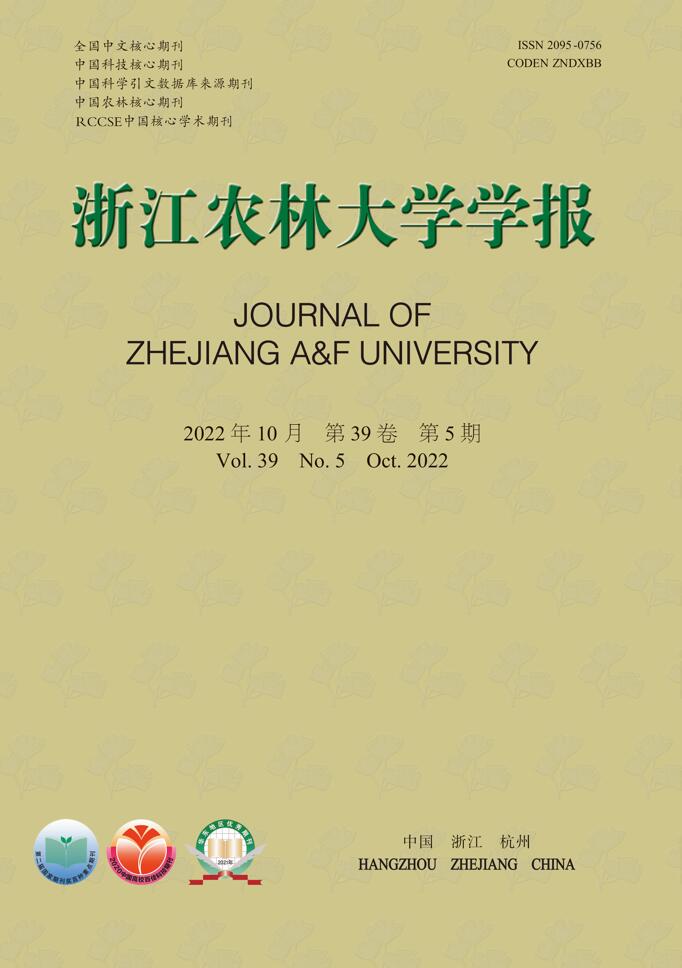-
肥料农药的大量使用、化石燃料的燃烧、采矿和冶炼、城市废物的处理以及污水污泥的产生等人为活动,导致土壤重金属污染日趋严重[1-2]。2014年《全国土壤污染状况调查公报》显示:中国土壤总污染点超标率为16.1%,其中镉污染点位超标率占总超标点位的7.0%[3]。水稻Oryza sativa是中国最主要的粮食作物之一,同时又是容易富集重金属的粮食作物[4-5],因此,在重金属污染土壤中生产的稻米已成为重金属进入人体的重要途径之一[6]。有研究表明:人体过多的重金属累积会损害肾小球和肾小管,降低骨密度,导致骨质疏松,增加癌症风险等[7]。
为了缓解中国水稻土中广泛存在的镉污染,人们筛选和培育了低积累水稻品种[8]。在轻中度镉污染农田土壤中种植低吸收镉农作物,既具有经济效益又保障了粮食安全生产,是目前安全利用污染农田的研究热点[9-10]。据报道,不仅不同农作物吸收和积累重金属镉的能力存在差异,而且同一作物的不同品种之间也存在差异[11]。有研究表明:选择并培育遗传因子稳定的低吸收水稻品种,可作为重金属镉污染农田的安全来源[12]。通过试验筛选出的低吸收水稻品种已经投入使用,并且取得了很好的种植效果[13]。但也有研究表明:诸如环境、施肥和水管理等农艺措施的差异都会对作物镉的吸收和积累产生一定的影响[14-16]。因此,为了选择适合当地环境种植的低吸收水稻品种,本研究在镉污染地区农田中对5个水稻品种开展大田试验,测定不同生育期内不同水稻品种的各项生长生理指标,并分析镉在不同水稻品种植株中的积累和分布特征,为轻中度镉污染耕地安全利用和粮食安全生产提供参考。
-
水稻试验大田位于浙江省丽水市景宁畲族自治县某村,属亚热带季风气候,四季分明,存在着垂直地带。年平均气温为18.3 ℃,年降水量为1 824.8 mm。年均日照时数为1 510.2 h。对水稻种植区土壤和农业生产进行摸底调查,全面掌握修复前各个地块本底环境状态以及相关历史资料。通过实施区的摸排与试验区块的确认,在该村划分出4 hm2的试验区。该试验区土壤pH为5.1,试验区表层镉超标率达99%,最高值为2.91 mg·kg−1,主要来源于大气沉降、秸秆还田以及前几年田块附近开矿。
-
供试低吸收水稻品种为‘中浙优1号’‘Zhongzheyou 1’、‘中浙优8号’‘Zhongzheyou 8’、‘华浙优71’‘Huazheyou 71’、‘甬优17’‘Yongyou 17’和‘甬优1540’‘Yongyou 1540’,其种子均在当地种子专卖店统一采购。
供试水稻于2019年6月插秧种植。在选定的耕地里设置5个处理,每个处理3个重复,共15个小区,每个小区面积均为30 m2。小区试验全部采用人工移栽的插秧方式,将不同水稻品种的种子播种于事先平整好的育秧地,按照不同品种划分各自育秧地块,在整个育秧阶段通过常规农艺措施保证秧苗水肥供应。秧苗生长35~40 d进行大田移栽,株行距为25 cm×20 cm,每穴2~3株,浅插匀植。种植前按照600 kg·hm−2的复合肥作为基肥[复合肥品牌为稻香源,氮+五氧化二磷+氧化钾质量分数≥50%,m(N)∶m(P)∶m(K)=25∶5∶20]。在秧苗移栽大田后10~15 d进行追肥,追肥采用150 kg·hm−2的尿素,其他水稻管理与当地常规管理模式保持一致。供试土壤为浙江省丽水市景宁畲族自治县某村镉污染地区土壤,供试耕地土壤的基本理化性质见表1。
pH 有机质/(g·kg−1) 碱解氮/(mg·kg−1) 速效磷/(mg·kg−1) 速效钾/(mg·kg−1) 全镉/(mg·kg−1) 4.58±0.26 7.59±0.49 203.97±7.61 44.52±1.04 193.69±2.28 2.36±0.64 Table 1. Basic properties of tested soil
-
根据HJ/T 166—2004《土壤环境监测技术规范》,采集耕作层0~20 cm的土样[17]。为了使采集的土壤样品更具代表性,尽量规避土壤本身空间分布不均造成的影响。采用多点取样,再混合成1个混合样品。每个样品1.0 kg。采样后带回实验室风干,磨细后,用10目和100目的筛子过筛后装袋备用,用于测定大田土壤基本理化性质、全镉质量分数及有效镉质量分数[18]。
试验过程中,分别在水稻分蘖期、拔节期、育穂期和成熟期采集土壤样品及水稻样品。采集后的土壤样品自然风干,研磨,去除动植物残渣和石头,分别过10目和100目备用;水稻样品用去离子水洗干净后,105 ℃杀青30 min,在75 ℃烘干至恒量,再将试验各时期水稻分为根、茎、叶、穗(育穂期和成熟期)、籽粒(成熟期),然后用粉碎机把所有样品碾碎后,用100目筛过装袋备用。
-
土壤全镉采用三酸消解法测定[19]:称取研磨通过100目筛子的均匀土壤0.100 0 g于50 mL聚四氟乙烯坩埚中,再用实验用去离子水湿润土壤,然后加入7 mL氟化氢溶液和5 mL浓硝酸溶液,在电热板上消煮蒸发至近干燥,取下聚四氟乙烯坩埚,冷却后,加入1 mL高氯酸,继续消煮到不再冒白烟,坩埚内残渣呈均匀的浅色(呈凹凸状为消煮不完全)。若消煮不完全,则添加1mL硝酸继续加热溶解残渣,至溶液完全澄清后转移到50 mL容量瓶中,定容摇匀,过滤保存,然后用石墨炉原子吸收光谱仪(岛津AA-7000,日本)测定镉元素。
土壤有效镉的测定[20]:称取10.0 g过2 mm筛孔的风干土样于100 mL塑料瓶中,加入20 mL DTPA浸提剂。在振荡机上振荡2 h,过滤取上清液,用石墨炉原子吸收光谱仪(岛津AA-7000,日本)测定镉元素。
植物样分析:称取0.3 g植物样品于消煮管中,加入5 mL的浓硝酸,在消煮仪中160 ℃消煮2 h,消煮完成冷却后,用蒸馏水定容至25 mL,采用石墨炉原子吸收光谱(岛津AA-7000,日本)测定。所有药品及试剂均为优级纯或基准试剂。
-
采用Excel 2016和SPSS V13.0 进行方差分析(ANOVA)和最小差异显著法(LSD)分析。采用SigmaPlot 12.5绘图。富集系数(FBA)=稻米镉质量分数/土壤镉质量分数。转移系数(TF)=水稻组织(茎、叶、壳和米)镉质量分数/水稻组织(根、茎、叶和壳)镉质量分数。
-
如图1A所示:不同水稻品种在分蘖期根、茎、叶全镉质量分数基本一致。不同水稻品种根部镉质量分数都高于茎、叶片中的镉质量分数。不同水稻器官对镉的吸收累积是不同的,其中‘中浙优8号’‘甬优17’‘华浙优71’等3个水稻品种不同器官吸收的镉从大到小依次为根、茎、叶,而‘中浙优1号’和‘甬优1540’茎部在分蘖期的吸附累积量略高于叶部;不同品种根和叶对镉吸收积累无显著差异(P>0.05)。如图1B所示:5个水稻品种在拔节期根部镉质量分数均高于茎部、叶部,各器官对镉的积累存在一定的规律性,从大到小均表现为根、茎、叶。‘甬优17’和‘华浙优71’水稻品种的茎和叶镉质量分数显著低于‘中浙优1号’和‘中浙优8号’(P<0.05)。5个水稻品种在孕穗期各器官对镉的吸收和积累从大到小依次为根、茎、叶、穗,即在土壤中根部吸收积累镉的数量高于茎、叶和穗(图1C);‘华浙优71’水稻品种的穗镉质量分数显著低于其他品种(P<0.05)。在成熟期时,‘中浙优1号’‘甬优17’和‘华浙优71’等3个水稻品种的根镉质量分数小于茎,高于叶,‘中浙优8号’和‘甬优1540’等2个水稻品种的不同器官对镉吸收和积累的量从大到小依次为根、茎、叶、糙米、稻壳;不同水稻品种中,‘华浙优71’的根镉质量分数显著低于其他品种(P<0.05),‘中浙优8号’水稻品种的茎和糙米镉质量分数显著低于其他品种(P<0.05)。

Figure 1. Differences in Cd contents in rice roots, stems, leaves, husks, and brown rice in moderately polluted soils at different growth periods
同一水稻品种在不同生育期阶段的相同器官中的镉积累情况不同,根茎叶中镉质量分数从小到大依次为分蘖期、拔节期、孕穗期、成熟期。
-
由表2可知:‘中浙优8号’土壤有效镉和全镉质量分数最高,分别为(0.64±0.35)和(1.82±0.05) mg·kg−1;‘甬优17’土壤有效镉和全镉质量分数最低,分别为(0.28±0.17)和(0.94±0.37) mg·kg−1。这可能是‘中浙优8号’对镉的吸收能力较弱,导致土壤中的镉质量分数无显著变化,而‘甬优17’吸收了土壤中大量的镉,导致土壤中的镉减少。
水稻品种 土壤有效镉/
(mg·kg−1)土壤全镉/
(mg·kg−1)有效镉/
全镉/%‘中浙优1号’ 0.41±0.08 a 1.55±0.28 a 32.80 ‘中浙优8号’ 0.64±0.35 a 1.72±0.05 a 35.16 ‘甬优1540’ 0.46±0.29 a 1.56±0.58 a 34.03 ‘甬优17’ 0.28±0.17 a 1.64±0.37 a 29.68 ‘华浙优71’ 0.50±0.11 a 1.41±0.33 a 38.07 说明:相同小写字母表示品种间差异不显著 Table 2. Total Cd and available Cd in the soil of each test plot
-
表3显示了不同水稻品种对镉积累和转运的影响。水稻中镉的TF在‘甬优1540’‘甬优17’和‘华浙优71’中表现出相似的趋势:TF壳—米>TF根—茎>TF茎—壳>TF茎—叶,‘中浙优8号’表现出TF壳—米>TF根—茎>TF茎—叶>TF茎—壳,在‘中浙优8号’水稻中观察到最低TF为0.06。镉在糙米中的FBA从大到小依次为‘中浙优1号’‘甬优1540’和‘华浙优71’‘甬优17’‘中浙优8号’。
水稻品种 TF根—茎 TF茎—叶 TF茎—壳 TF壳—米 FBA米 ‘中浙优1号’ 1.17 0.33 0.21 1.14 0.14 ‘中浙优8号’ 0.97 0.45 0.06 2.24 0.07 ‘甬优1540’ 0.92 0.14 0.31 1.50 0.10 ‘甬优17’ 1.01 0.08 0.20 2.29 0.08 ‘华浙优71’ 1.49 0.13 0.30 1.82 0.10 Table 3. Accumulation and transport characteristics of Cd in Rice
-
由表4可知:不同水稻品种产量为(5 137.5~7 549.5) kg·hm−2,均值为6 762.3 kg·hm−2。在5个水稻品种中,‘中浙优8号’产量最高,为(7 549.5±29.3) kg·hm−2,显著高于其他品种(P<0.05);‘甬优17’品种水稻产量最低。在各水稻品种中,‘中浙优8号’水稻千粒重和分蘖数最高,分别为(34.87±3.46) g和(24.22±2.55)个·丛−1。
水稻品种 产量/
(kg·hm−2)千粒重/g 分蘖数/
(个·丛−1)‘中浙优1号’ 7489.5±31.1 a 27.00±2.56 bc 14.89±2.12 c ‘中浙优8号’ 7549.5±29.3 a 34.87±3.46 a 24.22±2.55 a ‘甬优1540’ 6114.0±570.6 b 25.93±3.94 bc 21.56±4.17 ab ‘甬优17’ 5678.0±636.5 b 25.57±1.14 c 16.11±2.12 bc ‘华浙优71’ 6980.6±611.2 a 30.60±0.92 ab 22.00±3.84 c 说明:不同小写字母表示不同品种间差异显著(P<0.05) Table 4. Statistics of various growth indicators of rice
-
稻米镉与土壤有效镉、土壤全镉、水稻产量、千粒重和分蘖数的相关性分析可知(表5):土壤有效镉与土壤全镉具有极显著相关关系(P<0.01),稻米镉与分蘖数显著相关(P<0.05),千粒重与水稻产量和分蘖数显著相关(P<0.05),稻米镉与土壤有效镉、全镉无显著相关。
项目 稻米镉 土壤有效镉 土壤全镉 水稻产量 千粒重 分蘖数 稻米镉 1 土壤有效镉 0.151 1 土壤全镉 −0.029 0.885** 1 水稻产量 0.103 0.500 0.335 1 千粒重 −0.354 0.348 0.352 0.574* 1 分蘖数 −0.527* −0.066 −0.112 0.203 0.603* 1 说明:*和**分别表示在0.05和0.01水平上显著相关 Table 5. Correlation analysis of Cd contents in rice and soil and their growth characteristics
-
由于水稻根系和土壤中重金属镉直接接触,水稻根部是吸收和积累镉的主要部位[21]。龙小林等[22]探究了镉胁迫下粳、籼稻对镉元素的吸收特征,得出水稻各器官对镉吸收从小到大依次为谷壳、糙米、叶、茎、根,与本试验结果相似。不同于上述研究的是本研究为大田验证试验。成熟时,稻壳对镉的吸收和积累低于根、茎和叶,其平均吸收量为0.150 mg·kg−1,糙米中的平均镉质量分数也高于稻壳,为0.198 mg·kg−1。糙米的镉平均质量分数占根系的8.75%、茎部的11.71%和叶片的24.36%,这表明水稻中的镉是垂直向上转移的。水稻根、茎和叶中的镉有可能被运输到米粒中。由于不同低吸收水稻品种自身基因型不同,所以决定了不同水稻品种在轻中度污染土壤中其植株不同器官镉的累积量在不同生长发育期存在显著差异,因此品种差异是影响水稻对重金属元素吸收的主要因素[23]。相关研究表明[24]:水稻对重金属的耐受性和吸收能力具有明显的品种差异性。本研究中,‘中浙优8号’水稻对镉的吸收能力最小,适合在镉污染土壤中种植。王宇豪等[25]通过大田试验筛选低积累水稻品种,表明不同水稻品种中镉的分布特征和积累能力存在显著差异。
土壤中的有效镉含量一定程度上会影响水稻籽粒中的镉含量[26]。不同基因型水稻对镉的亲和、耐受、吸收积累差异较大[27]。本研究中,稻米镉质量分数与土壤有效镉、土壤全镉无显著相关。因此,不能依据土壤有效镉质量分数对不同水稻品种糙米镉质量分数进行评价。
在进行水稻低积累品种筛选时,不仅要考虑其本身低积累特性,还要考虑其在重金属镉影响下,植株体内重金属转运特性[28]。不同水稻品种镉的吸收与各部位的转运能力存在差异[29],镉在水稻中最主要的转运步骤为木质部—韧皮部的转移[30]。本研究发现:相比其他水稻品种,‘中浙优8号’TF茎—叶最高,TF茎—壳最低,说明在镉胁迫下,‘中浙优8号’有效地把重金属镉从茎部转移到叶部,降低了茎部到籽粒的转移,同时降低了籽粒镉积累的风险。在进行水稻低积累品种筛选时,也要考虑在镉影响下的产量及生长状况[31]。有研究表明:不同水稻品种在镉胁迫下,其产量和生长状况存在显著的差异[32]。综合水稻生长及产量和水稻稻米镉的积累情况,推荐‘中浙优8号’作为该区适宜种植的水稻品种,既能保证水稻的产量,又能保证水稻的质量安全。
-
同一水稻品种不同器官中镉的积累存在差异,在分蘖期镉质量分数从大到小依次为根、茎和叶,在拔节期和孕穗期,镉质量分数从大到小依次为根、茎、叶、穗;在成熟期,除‘中浙优8号’外,其余水稻品种镉质量分数从大到小依次为茎、根、叶、糙米、稻壳;在不同水稻品种中,‘华浙优71’的根镉质量分数显著低于其他品种,‘中浙优8号’的茎和糙米镉质量分数显著低于其他品种。同一水稻品种在不同生育期根茎叶中镉质量分数从小到大依次为分蘖期、拔节期、孕穗期、成熟期。在不同水稻品种中,‘中浙优8号’土壤有效镉和全镉质量分数最高,‘甬优17’土壤有效镉和全镉质量分数最低。不同水稻品种糙米中吸收和积累的重金属镉与分蘖数具有显著相关关系,与千粒重、水稻产量等水稻生长指标,以及土壤全镉和土壤有效镉无显著关系。
综合分析可知:‘中浙优8号’稻米中的镉质量分数较低,可以达到耕地安全利用、粮食安全生产的目的。
Transfer coefficient and distribution characteristics of Cd in low absorption rice cultivars under Cd stress
doi: 10.11833/j.issn.2095-0756.20210402
- Received Date: 2022-02-12
- Accepted Date: 2022-07-04
- Rev Recd Date: 2022-06-27
- Available Online: 2022-09-22
- Publish Date: 2022-10-20
-
Key words:
- low absorption /
- Cd stress /
- rice /
- transport mechanism /
- distribution
Abstract:
| Citation: | JIA Junwei, CHEN Zhenhua, LIAO Shiyan, et al. Transfer coefficient and distribution characteristics of Cd in low absorption rice cultivars under Cd stress[J]. Journal of Zhejiang A&F University, 2022, 39(5): 1059-1066. DOI: 10.11833/j.issn.2095-0756.20210402 |










 DownLoad:
DownLoad: